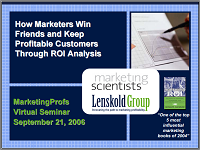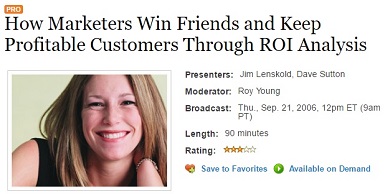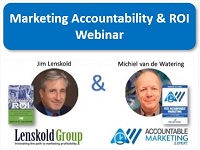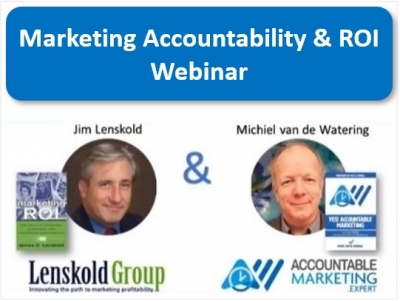Since marketing ROI surfaced to the top of marketing executives’ priorities six or so years ago, the debate over marketing being more art or science has been endlessly debated without resolution. Marketing’s creative side is essential to engaging customers and the science of measurement and analysis is essential to managing performance. Strong cases have been made for both sides of the debate and, in my opinion, neither side wins out. Marketing should not be viewed as art or science, but as business, plain and simple. You spend corporate dollars and are expected to deliver revenues and profits back to the business, whether you do this artistically or scientifically.
Chief Marketing Officers (CMOs) and senior marketing executives must manage marketing performance with clear alignment to business goals to deliver short-term and long-term cash flow, growth, and profits. While most marketing strategies are designed with business goals in mind, the disciplined planning still falls short. As marketing executives head into 2008 planning, there are five key steps to follow to elevate your leadership role and better manage performance. And if any of these steps are made difficult by shortfalls in your systems, knowledge, or culture, then your goal is to make 2008 the time to improve your capabilities so you do not fall further behind.
1. Set quantified objectives and use KPIs aligned to business goals.
Not all marketing is intended to deliver revenue on its own but all marketing is ultimately intended to drive incremental revenue at some point time. Generating awareness, preference, engagement, or leads all contribute to the overall sales process, each playing a critical role in acquiring, retaining, and growing profitable customers. But these and the other stages in the customer funnel are not the end objective and are potentially not even good metrics unless put into the right context.
Setting revenue or profit objectives is much easier if you have historical analysis or measurements that create a link between your marketing efforts, changes in customer attitude or behaviors, incremental purchase activity, and financial value. But many marketers have not run measurements to have this information readily available. As a marketing leader, you want your organization to go through the discipline of at least quantifying their assumptions using the best information available.
The idea is to follow the impact and find the contribution.
You start by developing the strategy and tactical plan to implement with a specific budget. Before you finalize this plan, you need to ask your team questions to follow the course of impact and quantify your assumptions. For example, consider the following series of questions.
- What do you expect to occur as a result of your marketing initiative?
- And then what happens between your impact and the point where they are purchasing or repeat purchasing your products and services?
- How many customers will be impacted?
- Are they current customers, competitor customers, or new to your category?
- What is the expected time period for purchasing behavior to begin and what is the expected duration of your impact?
All of these questions connect the marketing plan to the business impact. But questions like these are not always addressed when the approach is to implement good quality marketing and assume a portion of those exposed to our message will change their mindset and possibly their purchasing decisions.
Not all of the marketing and sales activity that follows is within your control but surely your efforts are intended to work effectively with these other touchpoints. The discipline of quantifying your assumptions will make your planning more strategic, lead to greater dialogue with your peers responsible for other parts of the sales cycle, and lead to better integration. And you can more easily identify the right key performance metrics based on knowing your impact flow, the quantities at each stage of engagement, and the timing.
The same discipline works for long-term brand positioning and customer experience initiatives, even though the time horizon is extended. These types of metrics are best managed as part of a balanced scorecard so that marketing investments are properly allocated to both short-term and long-term financial health.
2. Plan your marketing with good insight on profit drivers.
Driving profitable growth ultimately requires a good ROI process and the financial framework to support it. As you gain additional insight into the drivers of profitability at both the product/service and customer level, the marketing organization can significantly improve its ability to manage and deliver bottom line impact.
Tracking revenues is important but limits marketing’s ability to optimize budget allocation. Strong marketing leaders need to educate the organization on the profit impact of different products and services, customer purchase patterns, the impact of the customer experience on customer tenure (retention) and cross-purchasing. Financial insight needs to be accessible to the marketing team in an easily manageable format so it can be incorporated into the planning process. This information can effectively guide customer targeting, the product/service mix, management of the customer relationship, and budget allocation (applying a technique we call value-tiered marketing).
3. Apply comprehensive measurements and analysis to gain competitive advantage.
Good marketing leaders recognize the value of outsmarting the competition, understanding customers, and experimenting with new marketing approaches. A culture that recognizes the value of a continuous cycle of learning will put good measurements and analyses in place to provide marketers with performance feedback. Improving effectiveness is dependent on knowing what works, what doesn’t, and why.
Do you struggle with the fact that your business model makes it difficult to get good measurements? Congratulations, an extra effort on your part to get innovative and capture insight through measurements is very likely to put you ahead of the competition so you can win a greater share of the most profitable customers. Keep in mind that if it was easy, everyone would be doing it.
Highly reliable measurement methodologies are still under-utilized by many marketers (see the 2007 ROI Measurements and Processes Trend Study). Marketing executives must step up and fund more measurements and analysis and also set the expectations that the organization must not just report on measurement but apply this knowledge.
4. Identify and prioritize performance improvements with the greatest profit potential.
With objectives aligned to business goals, insight into key profit drivers, and measurements and analyses on marketing performance in place, marketing executives can better identify and prioritize where to focus their improvements. In some cases, the most profitable portion of the customer base can serve as a model to which the priority is to manage additional customers toward the same type of relationship. More likely, the greatest profit opportunities will come from better targeting, a better customer experience, better integration, or better experimentation.
Targeting has the greatest impact on marketing ROI. Marketing and sales efforts must be targeted toward the segment of customers that are both high in total value (short term and long term) and high in conversion potential (purchasing in response to your efforts. The customer experience is also critical since it determines the long-term value of acquired customers based on their likelihood to continue purchasing.
Better integration is a common gap that comes from not managing the customer’s buying journey or “funnel” as one continuous progression with marketing activities aligned to deliver incremental sales. Profit improvements also come from better experimentation as marketers develop and test diverse strategies and tactical plans with good measurements in place to breakthrough marketing initiatives.
Improvement opportunities are likely to exist across these key areas so if you are looking for just the top priority, the first step is to run financial analyses using historical trends to determine the sensitivities and upside potential of different improvements on profits.
5. Take action, deliver results, and push for more.
Too often, marketing measurements and analyses are used for nothing more than reporting. ROI analyses are used to justify past marketing expenditures and fill in static dashboards. Marketing leaders must shift this mindset so marketing is viewed as a “managed investment.” Marketing executives build credibility and respect among C-level executives as they demonstrate strength in continuously improving effectiveness as well as responding to both positive and negative changes in market conditions. The initial point of applying new insight on profitability and performance establishes a commitment and proves the value to the marketing organization (where skeptics are likely to exist). ROI analysis may start as a process to “speak the language of the CEO and CFO,” but it clearly becomes more significant when the process allows marketing to “deliver on the key metrics of the CEO and CFO.”
With greater credibility and confidence, marketing is better positioned to secure necessary budgets and earn that seat at the boardroom table. And the role of marketing expands as they manage the impact on customer value that each part of the business influences.








 Historical CLV accounts for each customer’s actual lifetime value going back to the very start of the relationship. Historical CLV is used to create predictors of Projected CLV.
Historical CLV accounts for each customer’s actual lifetime value going back to the very start of the relationship. Historical CLV is used to create predictors of Projected CLV.